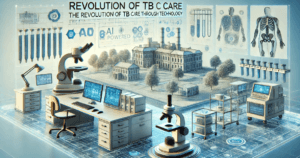Revolutionizing TB Care: How Technology is Transforming Diagnosis and Treatment
Technology is playing an important role in improving tuberculosis (TB) care by addressing long-standing challenges. TB treatment, which once took six to nine months, is now being shortened thanks to new medications, though it still remains demanding. Treatment for drug-resistant TB could take up to two years with limited success, posing a major health threat. Traditional sputum tests have limitations, especially for children, people with HIV, and drug-resistant strains. The Indian government’s initiative to expand diagnostic tools using blood, saliva, or stool samples is aligned with WHO recommendations.
AI is also helping by analyzing slides and X-rays, especially in rural areas with fewer healthcare professionals. Technology is also aiding in treatment monitoring, with new tests that detect medication adherence through saliva. However, while technology is essential, it must be combined with better patient nutrition and improved access to medicines to be truly effective in combating TB.

Revolutionizing TB Care: How Technology is Transforming Diagnosis and Treatment
Tuberculosis (TB) has long been a global health challenge, but recent advancements in technology are paving the way for better care and outcomes. Traditionally, TB treatment required immense patience: six to nine months of daily antibiotics for standard cases and up to two years for drug-resistant strains, often accompanied by harsh side effects such as nausea or hearing loss. While newer drugs, like bedaquiline and pretomanid, have shortened treatment for drug-resistant TB to 6–9 months, sticking to the regimen remains challenging. Missing doses or stopping treatment early can lead to relapse or fuel drug-resistant strains, which are deadlier and more contagious. This makes consistent treatment crucial not only for patients but also for community health.
Diagnosing TB: Breaking Free from Old Limitations
Accurately diagnosing TB has always been challenging. The standard sputum test—examining mucus under a microscope—fails many patients. Children struggle to produce enough sputum, while people with HIV or drug-resistant TB often have low bacterial levels, leading to false results. In 2023, the World Health Organization (WHO) identified diagnosis as a critical weak point in TB care. To address this, countries like India are adopting advanced methods. Molecular tests, such as GeneXpert, analyze DNA from blood, saliva, or stool, delivering results within hours and identifying drug resistance. These tools are faster and more reliable, aligning with WHO’s push for innovation.
Artificial Intelligence (AI) is also transforming diagnostics. In rural areas with few specialists, AI tools like ‘qXR’ scan chest X-rays for signs of TB, matching human experts’ accuracy. This helps clinics without radiologists diagnose quickly, reducing delays that allow the disease to spread.
Monitoring Treatment: Technology Keeps Patients on Track
Once diagnosed, ensuring patients complete their treatment is crucial. New innovations, like saliva tests, check if medications were taken in the last 24 hours by detecting drug traces. This real-time monitoring allows health workers to intervene early—whether a patient faces transportation issues or forgets a dose—thus preventing missed doses. In remote regions, mobile apps send dosage reminders, while community health workers use portable devices to track progress.
Beyond Technology: The Human Side of TB Care
Technology alone isn’t enough. Malnutrition weakens immunity, hindering recovery, so food support programs are essential. Similarly, erratic access to medicines remains a barrier. Stockouts or costly drugs force patients to abandon treatment. Solutions like free medication programs and local health workers delivering pills address these gaps. Counseling and education also play a role in reducing stigma and empowering patients to stay committed.
Conclusion: A Holistic Fight Against TB
The fight against TB thrives when technology complements human-centered care. Advanced diagnostics, AI, and monitoring tools are game-changers, but their impact multiplies when paired with nutrition, accessible medicines, and community support. By merging innovation with empathy, we can turn the tide against TB, save lives, and build healthier futures.
You must be logged in to post a comment.